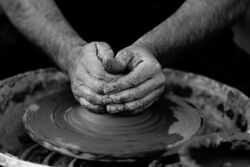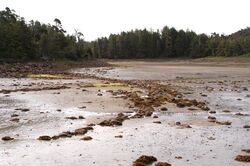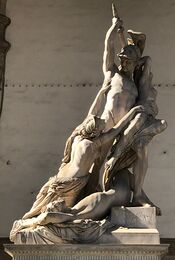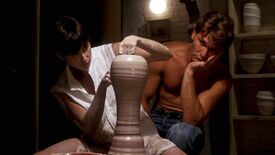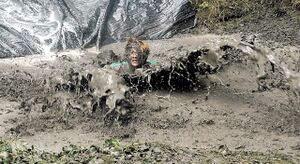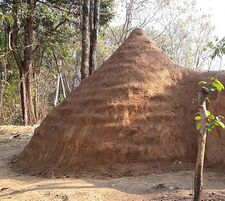Clay
Clay is a type of fine-grained natural soil material that contains hydrous aluminium phyllosilicates (clay minerals) that develops plasticity when wet.
History
The presence of clay in folk law goes back to prehistoric times. Indigenous peoples around the world still use it widely for geophagy, which beyond the polite convocations of research academia, means "eating dirt".
The first recorded event involving clay dates back to ancient Mesopotamia, predominately on the sticky shores of the Tigris-Euphrates river systems. The Sumerians and Akkadians (including Assyrians and Babylonians) found themselves up to their waists in it, while trying to escape the Achaemenid Empire, who subsequently got all eight legs dug in as far as the metatarti fleeing from Alexander the Great, who also got stuck because he was not wearing his wellies.
Having utilized horses, bits of wood and giant webs to extract the warring civilisations/arthropods/bloke, it was discovered their toenails/claws were spotlessly clean, their cuticles baby-soft, healthy, radiant, blemish-free, and younger-looking; with reduced pores... here comes the science bit... because of the skin-lifting peptides.
A wide variety of clays are for medicinal purposes — primarily for external applications (smearing), but also internally (shoving and poking). Among the clays most commonly used for medicinal purposes are Bentonite, Montmorillonite, and Marmite.
Questions of nomenclature
There are considerable problems with the exact nomenclature of clays, as they are just found on the ground. No clay deposit is exactly the same and mineral clays are mixed in various proportions with loams, dust, excrement, dead birds, ketchup sachets, and old bikes.
The majority of clay mined commercially is for a variety of industrial uses, such as in making flower pots and wine jugs. The precise classification and chemical composition of these clays are secondary to their intended use, which is ultimately as a projectile to conclude arguments between partners. Clays that are typically used for medicinal purposes have usually been discovered based on folklore, or simple trial-and-error by hemp-clad healing enthusiasts, doubting the medicinal propensity of the cold stones scattered across their stomach.
These discoverers were not too concerned about the clays' precise scientific classification and chemical properties, and not equipped other than with a shovel and dream catcher to conduct studies. Their primary, and often only, concern was to reduce itching from dermatitis neglecta, and open up opportunities to sell dirt to rich people.
Lemonian clay
This was the most famous clay in Classical Antiquity. Mined on the island of Lemnos, the fame of this reddish clay spread far and wide. In fact, Lemonian clay appears to have been in continuous use from the earliest antiquity to modern times. Its use continued until the 19th century, as it was still listed in an important pharmacopoeia in 1848.
According to legend, during the Trojan War, the hero Philoctetes was stranded on Lemnos with an injured foot giving off an unbearable stench. He was said to have been healed by an application of two plugs of Lemonian Earth up the nostrils.
As Pliny reports about the Lemnian Earth:
| “ | ...if rubbed under the eyes, it causes excruciating pain and stops watering from the same once the eyes are completely brown in colour. It then prevents the flow from the lachrymal ducts, drying the eyes out to the point they resemble chocolate coconut balls. It is used against complaints of the spleen and kidneys, as better than complaining about eyes full of clay. | ” |
Lemonian clay was shaped into tablets, or little cakes, and then distinctive seals were stamped into them, giving rise to its name terra sigillata (Latin for 'sealed earth').
Another physician famous in antiquity, Galen, recorded numerous cases of the internal and external uses of this clay in his treatise on clay therapy:
| “ | Galen... used as one of his means for curing aches and pains, temperatures, dizziness, headaches, cold and flu-like symptoms by prescribing two terra sigillata every six hours; a medicinal red clay compressed into tablets. This clay, which came from the island of Lemnos, also came in lemonian-flavoured 'Max Strength' sachets, for troops determined to remain on parade despite a heavy cold (and dry cough) impressing the Centurion, as well as giving it to other Legionnaires in time for the eve of battle."[1] | ” |
Clay was also prescribed by the Roman obstetrician, gynaecologist, and paediatrician Soranus of Ephesus, whose sore anus led him to invent pile-relief clay, "Anusol", and investigate other medical applications that it's best not penetrating too deeply.
Terra cymolia
Terra cymolia is a white earth that is considered of great value — because it answers the question on everyone's mind: can ceramics be erotic?
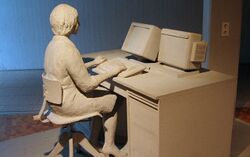
For those that enjoy all over texture with a super low shine finish, those that like to run their fingers through their hair for that just out of bed look, or voyeurs who find nothing more arousing than a sexy nude clay mould, Terra cymolia is the 'dozen oysters' of dirt.
Erotica in art has been explored mostly in contemporary art, photography and painting. But it is often forgotten that erotic art and interest in human sexual behaviour have been with us from the "dawn of humanity"; in fact sexual behaviour would have been the no.1 priority back then, if the human race ever intended to make it as far as the "lunchtime of humanity". To the delight of three-dimensional art lovers, clay provides the medium for some of the best sculptural works that deal with the theme of eroticism and sexuality.
From the Roman ancestors who were obsessed with eroticism as an inseparable part of the hedonist lifestyle, to Indian Kama Sutra art of love-making depicted in various sculptural forms, to some modern examples that continue the millennia-long interest in human sexuality.
Ghost
In the middle of the night, a woman sits alone at a pottery wheel. A vintage jukebox in her apartment switches records, and “Unchained Melody” by the Righteous Brothers pours into the room. Her boyfriend, shirtless, approaches, sits behind her, and reaches out his hand, accidentally ruining her pot. No matter — they begin a new one together, his hands interlaced with hers, stroking the wet clay. He begins kissing her, and she leaps into his arms, the pottery wheel abandoned as Demi Moore and Patrick Swayze give each other a right good seeing-to.
To prepare for her role, Moore had taken a few lessons. “I just didn’t want things to wobble,” she said in a Ghost featurette. “It was like a sure-fire sign that I was no good, and I was faking it.” Swayze didn’t need any formal training, but he did sit at the wheel to rehearse the scene with Moore for a number of weeks. "During early rehearsals there's a lot of footage of things flopping and spattering," production designer Jane Musky recalled, “that malleable, shiny-clay wetness, it was so sensual, splattered all over their faces.”
With the Internet still in its dial-up infancy, offering no realistic substitute to pondering erotic art, the love scene became the most iconic of the decade, responsible for spawning a rush of people taking up pottery as a hobby, as well as spawning most of the Millennial Generation.
Crud
Crud is the most common form of clay-composite, consisting of a combination of clay, crap and mud. It can be found in abundance outside the towns and cities around the mid-latitudes, mainly farmyards. It cannot be underestimated the significance Crud has played in the development of civilisation.
Architecture
In today's brightly-lit, sanitary world of Glade Plug-ins, Dettol Spray, and vacuum-cleaning robots, rich nations suffer from “collective amnesia” about the domestic commonality of crud. The Belgian architect and former adviser for architectural exhibitions at the Pompidou Centre in Paris, argues that crud was the world’s dominant building material for 10 millennia. The cruddy walls of the Alhambra in Spain stand proud after 700 years, as well as the seven-storey adobe proto high-rises of the 16th-century walled city of Shibam in Yemen, described as “the Crudhattan of the desert” is still home to 7,000 people.
Why did it fall out of favour as a building material? Many think crud’s very ubiquity worked against it as an ‘acapitalist’ material, which denied anyone an interest in exploiting it and unlike concrete, it has no industry lobby to promote it. Crud walls also attract flies and smell a little bit of shit on warm days.
Sports
Houston wrestling promoter Paul Boesch is credited with the concept of immersing in crud for sporting activity, when booking a feud between Gus Sonnenberg and Harnam Singh in Seattle, Washington, which he promoted as an "Indian Dirt Match." Its popularity in the United States increased in the '80s, and later spread worldwide, most notably becoming dominated by female competitors. It has become a medium for soccer, rugby, volleyball, track sports, and motorsport and has its own Olympics.
Cuisine
Culinary crud helps promote and encourage children to get back to playing outside with nature. In the past, it was common to see a child covered from head to toe in crap, merrily chewing on worms pulled fresh from the ground. Today’s childhood is rather more technologically-intensive, with children spending all of their free time sitting in front of a screen, killing virtual communists. Outdoor kitchens create the opportunity to practice social skills and help children make sense of the real world, by getting a severe dose of dysentery.
Research has shown that there are numerous benefits to eating crud; encouraging creative thinking, developing positive dispositions, improving cognitive function, and building healthy immune systems. As well as making children much more aware of what warfare is really about.
References
- ↑ Dr. H. Van Der Loos, The Miracles of Jesus. Leiden, the Netherlands, Brill, 1965. p. 82.
| Featured version: 21 September 2020 | |
| This article has been featured on the main page. — You can vote for or nominate your favourite articles at Uncyclopedia:VFH. | |
